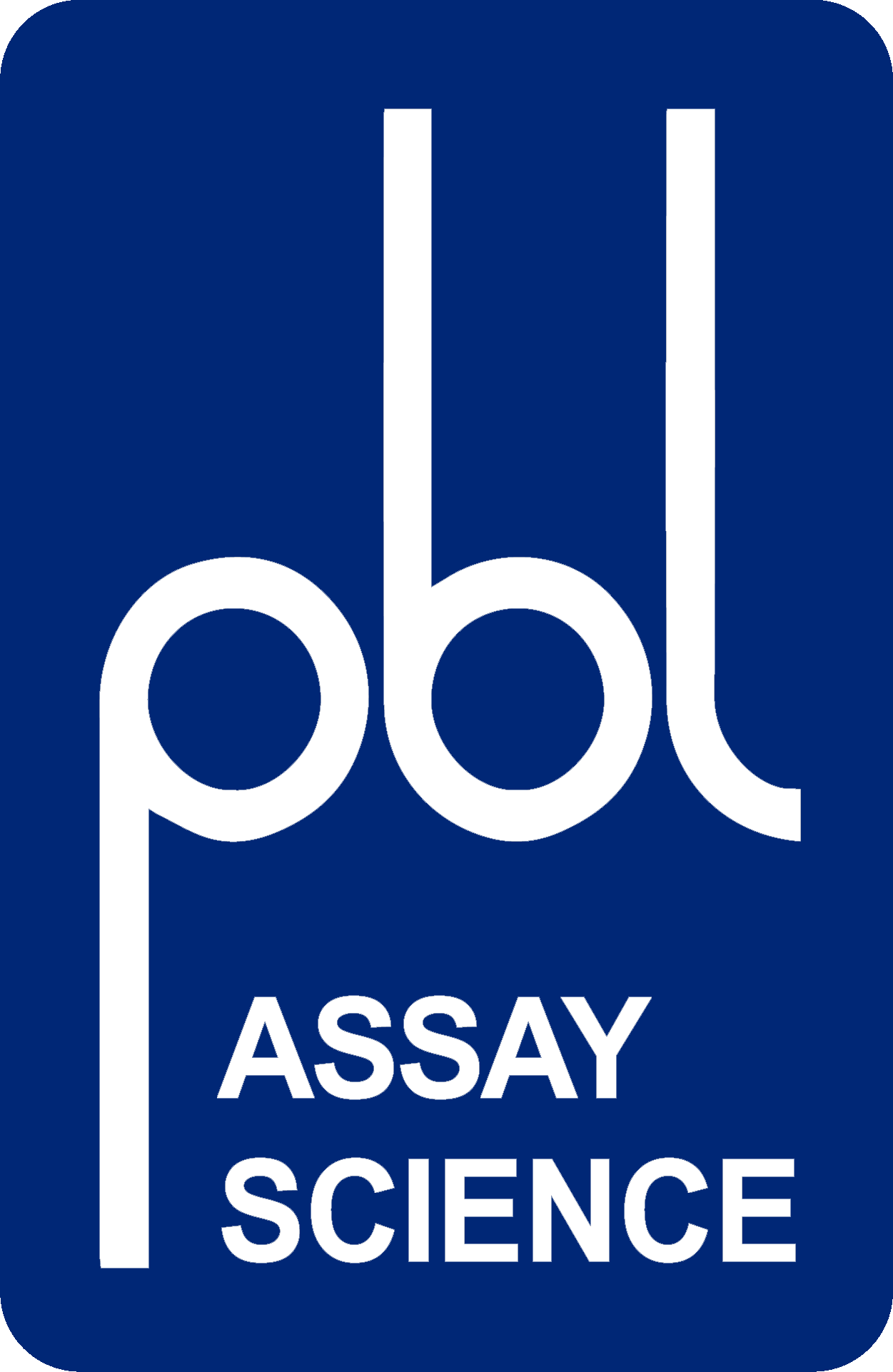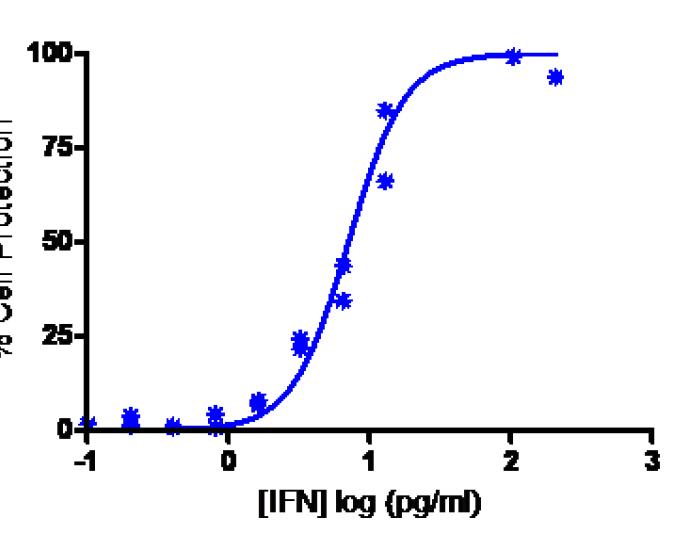Human IFN-Beta 1a, mammalian, carrier-free
Catalog Number: 11410
Useful for MS research studies, recombinant Human IFN-Beta 1a protein is expressed in CHO cells.
$620.00
Product Info
Supplied without a carrier protein and as a liquid to maintain higher specific activity.
Specifications
| Formulation | Supplied as a liquid without a carrier protein |
|---|---|
| Molecular Weight | ~ 23 kDa |
| Source | cDNA obtained from human fibroblast interferon beta 1a mRNA expressed in CHO cells |
| Purity | > 95% by SDS-PAGE stained by Coomassie Blue Endotoxin level < 1 EU/μg |
| Bioactivity | Measured using a cytopathic inhibition assay on human lung carcinoma cell line A549 with encephalomyocarditis virus (EMCV). EC50 for IFN beta 1a in this assay is ~1 U/ml |
| Storage | For retention of full activity store at 2-8°C. Further dilution of this product for long term storage is not recommended. |
| Synonyms | Human IFNB, Human Beta Interferon, Human IFN Beta 1a, Human Interferon beta 1a, Human Type I Interferon Beta, Human IFN B |
| Accession Number | V00534 |
Citations
22 Citations
- Pelz, A. et al., (2023), "Broad-Spectrum Antiviral of Influenza A Defective Interfering Particles against Respiratory Syncytial, Yellow fever, and Zika Virus Replication In Vitro", Viruses, 15(9):1872, DOI: 10.3390/v15091872 (link)
- Kurland, A.P. et al., (2023), "A Chemical Proteomics Approach to Discover Regulators of Innate Immune Signaling", Viruses, 15(5):1112, DOI: 10.3390/v15051112 (link)
- Beug, et al. (2019). The transcription factor SP3 drives TNF-α expression in response to Smac mimetics. Science Signaling, 16 pgs. PMID: 30696705. (link)
- Viswanathan, Kasinath, et al. (2017). Quantitative Membrane Proteomics Reveals a Role for Tetraspanin Enriched Microdomains During Entry of Human Cytomegalovirus. PLOS One, 27 pgs. PMID: 29121670. (link)
- Rahman, Masmudur, et al. (2017). Myxoma Virus dsRNA Binding Protein M029 Inhibits the Type I IFN-Induced Antiviral State in a Highly Species-Specific Fashion. Viruses, 22 pgs. PMID: 28157174. (link)
- Bowen, James, et al. (2017). Zika Virus Antagonizes Type I Interferon Responses During Infection of Human Dendritic Cells. PLOS Pathogens, 30 pgs. PMID: 28152048. (link)
- Iyer, Shilpa, et al. (2017). Resistance to Type I Interferons is a Major Determinant of HIV-1 Transmission Fitness. PNAS, 10 pgs. PMID: 28069935. (link)
- Schwarz, Toni, et al. (2016). VP24-Karyopherin Alpha Binding Affinities Differ Between Ebolavirus Species Influencing Interferon Inhibition and VP24 Stability. JVI, 44 pgs. PMID: 27974555. (link)
- Kativhu, Chido, et al. (2016). A Model to Explain How the Bacille Calmette Guerin (BCG) Vaccine Drives Interleukin-12 Production in Neonates. PLOS One, 12 pgs. PMID: 27571272. (link)
- Gao, Xioafei, et al. (2016). Citrobacter rodentium NleB Inhibits Tumor Necrosis Factor (TNF) Receptor-Associated Factor 3 (TRAF3) Ubiquitination to Reduce Host Type I Interferon Production. JBC, 15 pgs. PMID: 27387501. (link)
- Rasouli, Javad, et al. (2015). Expression of GM-CSF in T Cells Is Increased in Multiple Sclerosis and Suppressed by IFN-β Therapy. Journal of Immunology, 10 pgs. PMID: 25917097. (link)
- Li, Yanfang, et al. (2014). A 20-amino-acid deletion in the neuraminidase stalk and a five-amino-acid deletion in the NS1 protein both contribute to the pathogenicity of H5N1 avian influenza viruses in mallard ducks. PLOS One, 12 pgs. PMID: 24743258. (link)
- Mostafa, Heba, et al. (2013). Herpes Simplex Virus 1 ICP22 but Not U_S_1.5 is Required for Efficient Acute Replication in Mice and VICE Domain Formation. JVI, 10 pgs. PMID: 24089574. (link)
- Salvi, et al. (2013). Dual regulation of osteopontin production by TLR stimulation in dendritic cells. JLB. PMID: 23610145. (link)
- Wang, Bei, et al. (2013). Enterovirus 71 protease 2Apro targets MAVS to inhibit anti-viral type I interferon responses. PLOS Pathogens, 18 pgs. PMID: 23555247. (link)
- Patel, Dhara, et al. (2012). High Throughout Screening for Small Molecule Enhancers of the Interferon Signaling Pathway to Drive Next-Generation Antiviral Drug Discovery. PLOS One, 12 pgs. PMID: 22574190. (link)
- Popugaeva, Elena, et al. (2012). Dobrava-Belgrade hantavirus from Germany shows receptor usage and innate immunity induction consistent with the pathogenicity of the virus in humans. PLOS One, 10 pgs. PMID: 22545121. (link)
- Witte, et al. (2009). Despite IFN-lambda receptor expression, blood immune cells, but not keratinocytes or melanocytes, have an impaired response to type III interferons: implications for therapeutic applications of these cytokines. Nature, 13 pgs. PMID: 19798076. (link)
- Aguilar, Patricia, et al. (2008). A Five-Amino-Acid Deletion of the Eastern Equine Encephalitis Virus Capsid Protein Attenuates Replication in Mammalian Systems but Not in Mosquito Cells. JVI, 12 pgs. PMID: 18480443. (link)
- Reid, Patrick, et al. (2007). Ebola Virus VP24 Proteins Inhibit the Interaction of NPI-1 Subfamily Karyopherin α Proteins with Activated STAT1. JVI, 9 pgs. PMID: 17928350. (link)
- Suzuki, Michitaka, et al. (2007). Endosomal accumulation of Toll-like receptor 4 causes constitutive secretion of cytokines and activation of signal transducers and activators of transcription in Niemann-Pick disease type C (NPC) fibroblasts: a potential basis for glial cell activation in the NPC brain. Journal of Neuroscience, 13 pgs. PMID: 17314284. (link)
- LaFleur, David, et al. (2001). Interferon-kappa, a Novel Type I Interferon Expressed in Human Keratinocytes. JBC, 7 pgs. PMID: 11514542. (link)

